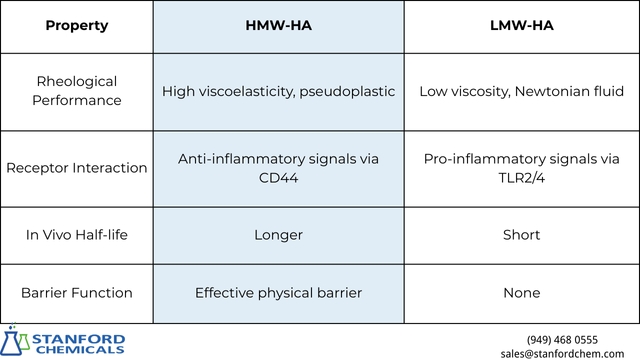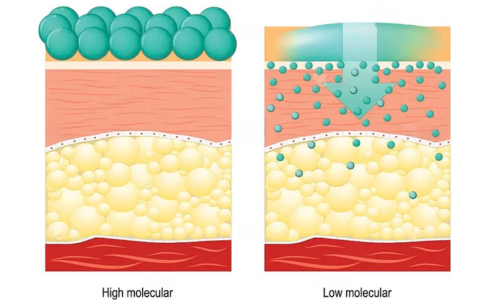Why Does High Molecular Weight Hyaluronic Acid Matter
Molecular weight is one of the most significant properties of hyaluronic acid (HA). Different molecular weights have different physicochemical properties and biological activities. High molecular weight hyaluronic acid (HMW-HA), typically above 1,800 kDa, has superior viscosity, lubrication, and stability properties and is of great benefit in skincare and medical therapy.
The Powerful Lubricating Effects of High-Molecular-Weight Hyaluronic Acid
While HA is generally best known for its moisturizing action, its lubricating action is also important. In biomedical applications, such as joint lubrication, ophthalmic surgery and post-surgical anti-adhesion, HMW-HA’s lubricating effect is primarily utilized.
Fig 1. High-molecular-weight hyaluronic acid possesses lubricating and viscoelastic properties.
–Joint Lubrication: HMW-HA is the Standard
HA is a necessary component of synovial fluid, and it is for this reason that physicians manage arthritis by the administration of HA injections. Synovial fluid naturally has HA with a molecular weight between 3,000–6,000 kDa. HMW-HA (which is frequently in need of cross-linking technology) proved to be the best of all the molecular weights. Clinical observation is that in patients with osteoarthritis, the synovial HA concentrations are below 500 kDa, resulting in a >50% loss of viscoelasticity. Thus, HMW-HA injections restore synovial fluid viscosity with improved joint lubrication.
–Ophthalmic Surgery: Relies on Ultra-High Molecular Weight HA
Ophthalmic viscosurgical devices (OVDs) typically use HMW-HA (>2,000 kDa). Its high stability and viscoelasticity allow it to remain longer in the eye, providing longer protection and support and reducing intra- and post-operative complications. In contrary, lower molecular weight HA cannot provide the required rheological performance and can cause corneal edema because of osmotic pressure issues.
–Post-Surgical Anti-Adhesion: HMW-HA as the Foundation
The high viscoelasticity of HMW-HA allows it to offer a physical barrier effect in operating sites for extended periods of time, delivering long-lasting anti-adhesion results. Additionally, its lubricating nature reduces tissue friction, minimizing injury and inflammation.
High vs. Low Molecular Weight Hyaluronic Acid: Anti-Inflammatory or Pro-Inflammatory
In addition to lubrication, HMW-HA’s uses in joint injections, ophthalmic surgery, and anti-adhesion also capitalize on its anti-inflammatory properties.
Fig 2. Smaller HA molecules absorb deeper into skin
–HMW-HA Effectively Suppresses Inflammation
It forms an anti-inflammatory covering on tissue surfaces that bars inflammatory cell invasion. It also controls pro- and anti-inflammatory factors, suppressing inflammation. On top of that, HMW-HA enhances tissue stability, promoting efficient healing of wounds. Hence, it is used quite often in arthritis treatment, skincare, and eye surgery to support healing.
–LMW-HA Does Just the Reverse—It May Promote Inflammation
LMW-HA (HA in the range of 10-200 kDa) engages cell surface receptors, including TLR4, activating inflammatory signaling and amplifying the generation of pro-inflammatory cytokines. While the body naturally breaks down HA into LMW-HA during tissue injury (helping initiate immune defense), excessive amounts can lead to chronic inflammation. Therefore, its use must be carefully controlled to balance pro-inflammatory and reparative effects.
Read more: Does Hyaluronic Acid Trigger Inflammation
Can High Molecular Weight Hyaluronic Acid Achieve Anti-Aging and Life Extension
HMW-HA is present in nearly all anti-aging skincare products. It works like a super sponge, forming a barrier film on the skin’s surface that locks in moisture. This makes the skin tight and elastic, smoothing out wrinkles and fine lines. Besides hydration, the film also protects against UV damage, shielding the skin from free radicals.
Benefits of HMW-HA to the Skin:
- Improves elasticity and firmness of skin
- Avoids sagging
- Smooths texture and enhances it
Other than dermatological treatment, studies showed that high molecular weight hyaluronic acid also exhibits medical anti-aging capabilities.
A groundbreaking study published in Nature revealed that increasing expression of the nmr Has2 gene (which produces more HMW-HA) in naked mole rats extended the life of test mice.[i] The study found that HMW-HA not only inhibits cancer but can possibly increase lifespan as well.
Conclusion
Due to its triple benefit of lubrication, anti-inflammatory, and anti-aging, HMW-HA occupies a replaceable niche in the therapy of joints, surgical assistance, and aging protection. Although LMW-HA can add flexibility to certain applications, HMW-HA’s stability and protective action render it popular in many clinical and cosmetic uses.
Stanford Chemicals Company (SCC) offers high molecular weight hyaluronic acid (HA) powder suitable for the pharmaceutical, cosmetic, and research industries. For more product information, contact professionals through the Get A Quote.
[i] Zhang Z, Tian X, Lu JY, Boit K, Ablaeva J, Zakusilo FT, Emmrich S, Firsanov D, Rydkina E, Biashad SA, Lu Q, Tyshkovskiy A, Gladyshev VN, Horvath S, Seluanov A, Gorbunova V. Increased hyaluronan by naked mole-rat Has2 improves healthspan in mice. Nature. 2023 Sep;621(7977):196-205. doi: 10.1038/s41586-023-06463-0. Epub 2023 Aug 23. PMID: 37612507; PMCID: PMC10666664.


